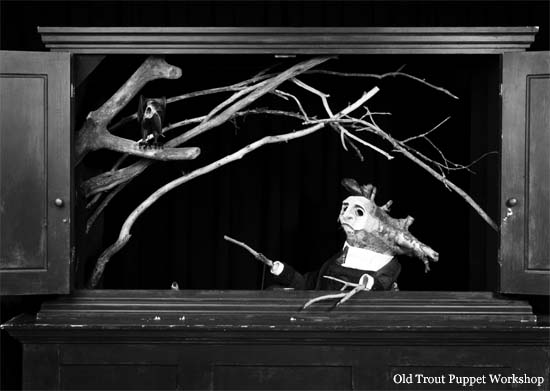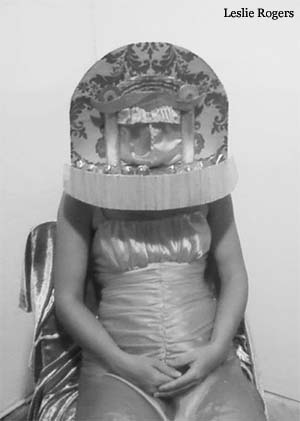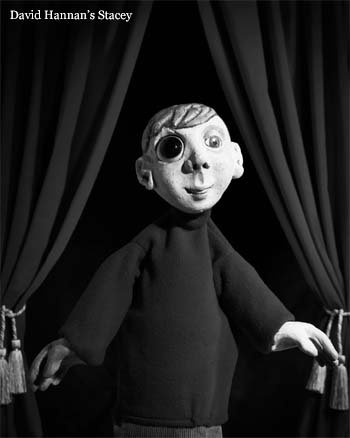The cake’s just crumbs and the kiddie party is over. You’ll never guess what the puppets get up to next. Think dark bars, staged executions and journeys to the centre of your soul…
By Lindsay Gibb
The lady on stage is screaming. Her legs are splayed, her makeup is smeared and the crowd leans forward, eager to see what’s coming next. The menacing mute in white-face looms over her, a nurse’s hat perched on his head. His newly found voice channels through the screaming woman. Wait, another creepy character moves eerily across the stage. Neatly bearded and wearing a Mr. Rogers sweater, he talks the audience through the horrific scene with a calm intensity akin to a children’s show host leading kids through story time. At the pinnacle of chaos, the “nurse” reaches between the woman’s legs. “Ah, ah,” the lady shrieks. She’s giving birth! To baby dolls? No. The white-faced man pulls them out. It’s rabbits. Soaking wet rabbits.
The story of Mary Toft, a real 18th Century woman from the English countryside who claimed she gave birth to rabbit parts, plays out via a puppet drama sandwiched between a twisted waltz and the tale of a moose in municipal politics. The occasion is The Friendly Rich Show, a vaudevillian event held at a club in Toronto best known for its late-night salsa dancing. David Hannan, whose creepy silent stare almost steals the show, is the white-faced controller of Mary Toft. Richard “Friendly Rich” Marsella is the storyteller. The audience is riveted. They’ve never seen anything like it.
 When we think of puppets, we think of children’s television and kid’s birthday parties. If we go any deeper, maybe we think, with a chuckle, about the cast of the musical Avenue Q, a coming of age Muppet show that jump-started convention by satirizing everything from racism to Internet pornography. A few of us might even have stumbled upon the Canadian TV show Puppets Who Kill, which ran for a few seasons and featured murderous puppets living in a group home. A cursory survey of pop culture would suggest that the puppet-as-adult-entertainment paradigm is already played out. Puppets who have sex and kill? It’s been done. Next?
When we think of puppets, we think of children’s television and kid’s birthday parties. If we go any deeper, maybe we think, with a chuckle, about the cast of the musical Avenue Q, a coming of age Muppet show that jump-started convention by satirizing everything from racism to Internet pornography. A few of us might even have stumbled upon the Canadian TV show Puppets Who Kill, which ran for a few seasons and featured murderous puppets living in a group home. A cursory survey of pop culture would suggest that the puppet-as-adult-entertainment paradigm is already played out. Puppets who have sex and kill? It’s been done. Next?
But go deeper, and you’ll find that there’s been a subculture of independent creators innovating with puppets since the 1960s. Go even deeper, and guess what? Puppet projects are emerging as one of the most interesting aspects of a contemporary underground performance culture. Call it the puppet underground — a scene inspired as much by indie rock and postmodern video art as by fairy tales and Jim Henson.
“I think there’s a renaissance occurring,” says Peter Balkwill, co-founder of the Calgary-based puppet troupe The Old Trout Puppet Workshop. For the last decade, The Old Trout, which started as an arts collective based out of a ranch in Southern Alberta, has been stunning audiences and soaking up praise for its innovative puppetry. The troupe builds and manipulates puppets to create everything from silent visual poems to pieces as disturbingly bleak as they are hilarious. Consider their popular Famous Puppet Death Scenes. It’s a collage of death scenes from other puppet shows, shows that don’t actually exist but were made up by The Trouts. The performance at once mocks the preciousness of theatre and embraces the immediacy of performance. In the end, we feel for each and every dying puppet, despite the ridiculousness of the setup. Satire embedded in genuine human emotion: isn’t that the alchemic potion of ironic feeling jaded audiences will go to any lengths to experience?
“What’s interesting about puppets, and why they are really effective tools in theatrical expression, is that they work as representations,” explains Balkwill. “You can draw vast swaths of metaphor and you can create scenarios that are more accepted by the audience because it isn’t an exact statement.”
The interpretive potential of puppets, the sense that a puppet is in many ways a blanker slate than a human being or even a painting, is what attracted video and print artist Libby Hague to the medium. Hague is currently creating a collaborative puppet video on the theme of the creation of life entitled free radicals. Never having worked with puppets herself, Toronto-based Hague put a call out for puppeteers, or people open to working with puppets, asking them to send her pitches interpreting this theme. The four successful candidates will work with Hague, using her sculptures for scenery, and perhaps even incorporating Hague-created puppets into their works. The obvious question, of course, is “why puppets?”
“I think because they leave so much room for the imagination,” she explains. “It’s not clearly laid out for us. We have to kind of work at projecting ourselves into these creatures just as the puppeteers actively project a personality into the puppet.”
One also gets the sense that both audiences and artists alike are growing tired of projects based on surveillance cameras, editing software, CGI and disembodied Internet audiences. There’s an increasing longing for the tangible, for the real, and what’s more tangible than making your characters out of papier-mâché? David Hannan, the creator of Mary Toft (our cover model) and frequent collaborator with musician Friendly Rich (they’re currently working together on a puppet opera), cites the simplicity and accessibility of puppets as the medium’s major appeal. “If it’s a good puppet and a good puppeteer doing it, I think the audience forgets about it being a puppet,” he says. Take Stacey, Hannan’s bulging eyed, asexual hand puppet that was modeled after Casey from Mr. Dressup. “I don’t know if it’s a male or female, and we come up with weird stories that the eye is bulging because it had Polio as a kid, and audiences grasp onto that.”
In 2009, Stephen Marche wrote an article for the Toronto Star which described Canada as a “hotbed for art puppetry.” “The puppet,” he went on to write, “has become the foremost means of resisting the mainstream — a way of reacting against mass-produced, technologically driven, personality-obsessed celebrity culture.” Puppets are by their very nature anti-celebrity, ironically more “real” than today’s plastic-enhanced super-stars. But that analysis has its limits. In the same way that zines don’t exist simply to counteract ezines, “art” puppetry has other advantages for the independent artist: puppets can be relatively cheap to work with, they’re immediate and in-yourface, and, perhaps most importantly, they’re impressively ambidextrous. Puppets are at ease in everything from sketches to art exhibits to music videos. Puppets can dance (even when their controller can’t), they can defy gravity, and they connect with audiences in ways artists and actors often struggle to. It’s not so much that independent creators are turning to puppets to resist the mainstream, it’s their versatility that makes them so attractive. In fact, artists who work with puppets often straddle the chasm between the mainstream and the underground. Puppets are the bridge.
 Philadelphia-based artist Leslie Rogers identifies herself as a sculptor from an institutional arts background. While puppets have become a large part of her practice, she doesn’t think of herself as a puppeteer — a definition that she seems to prefer to avoid, despite her apprenticeship with Bread and Puppet, a nearly 50-year-old political puppet theatre collective based on a farm in Vermont. In the past, Rogers’ puppet work revolved around the types of tragedies that can happen to anyone (everyman tragedies, as she calls them) and the deep moments that arise when her weird creatures play out the quotidian possibilities of life and death. In one of her earlier works, Rogers used chin faces (you know, the trick where you put eyes on your chin and turn upside-down to create an odd new visage) to create videos where individual chins would detail their innermost thoughts projected on mountain scapes or on the shoulders of a businessman. Rogers’ method to create narrative was to let the camera roll on a mouth, without speaking back to it, until the person behind the mouth had a moment of realization. “It was a fun piece to make because the things people were saying were really moving and provocative,” — one chin talks about the way she easily becomes abusive in her relationships — “but then you have to step out again and be like, ‘I’m looking at this fucked up looking chin puppet and it’s telling me about life,'” she says.
Philadelphia-based artist Leslie Rogers identifies herself as a sculptor from an institutional arts background. While puppets have become a large part of her practice, she doesn’t think of herself as a puppeteer — a definition that she seems to prefer to avoid, despite her apprenticeship with Bread and Puppet, a nearly 50-year-old political puppet theatre collective based on a farm in Vermont. In the past, Rogers’ puppet work revolved around the types of tragedies that can happen to anyone (everyman tragedies, as she calls them) and the deep moments that arise when her weird creatures play out the quotidian possibilities of life and death. In one of her earlier works, Rogers used chin faces (you know, the trick where you put eyes on your chin and turn upside-down to create an odd new visage) to create videos where individual chins would detail their innermost thoughts projected on mountain scapes or on the shoulders of a businessman. Rogers’ method to create narrative was to let the camera roll on a mouth, without speaking back to it, until the person behind the mouth had a moment of realization. “It was a fun piece to make because the things people were saying were really moving and provocative,” — one chin talks about the way she easily becomes abusive in her relationships — “but then you have to step out again and be like, ‘I’m looking at this fucked up looking chin puppet and it’s telling me about life,'” she says.
Her follow-up to the chin faces saw her placing dioramas, and eventually puppet shows, inside her own mouth. Creating tiny car wrecks and shark attacks on her tongue, Rogers eventually developed a puppet show with collaborator Zac Palladino (collectively called PuppeTyranny) where Palladino controls the puppets and Rogers is the stage. As the scene plays out with Rogers as a voiceless woman in a pretty dress with a small puppet stage surrounding her mouth and obscuring her face, Palladino controls the scene and plays with objects inside her mouth. Rogers sees this as a commentary on women in entertainment. “For me it’s satisfying because I’m participating in a way that’s so literal and over the top… that it’s so obvious that that’s happening everywhere.”
Northeast of Rogers, a late night cabaret-style puppet series has been similarly pushing the envelope of puppetry for the past 13 years. Creators Vanessa Gilbert and Jeremy Woodward started Blood from a Turnip as a way to give professionals who usually worked with kids, as well as novices who had never worked anywhere, an opportunity to play to a different audience. Based out of Perishable Theatre in Rhode Island, the late night puppet salon features artists who don’t mind straying from the standard definition of puppetry.
“The range of what is considered puppetry is probably a little broader at Blood From a Turnip than it would be at some of the other puppet venues,” says David Higgins, current co-curator of the series, and husband of co-creator Gilbert. “It’s more of a do-it-yourself atmosphere at Blood From a Turnip.” For example, Evan O’Television, now Gilbert’s partner in programming the salon, does an act he calls “video ventriloquism” where he talks to a video of himself throughout the show. The tightly edited and acted pieces feature many fast paced arguments between O’Television and his video self. In a media preview of his show Double Negatives before the 2010 New York International Fringe Festival, O’Television explained that the puppet community has embraced him despite the fact that he doesn’t really use puppets in his act. “Which is so nice of them. I mean, it really is a testament to what a kind and generous community they are because if you look at our act, it’s not like we actually perform real ventriloquism,” says the on screen version of O’Television, setting up a gag where his voice suddenly goes out of synch with his mouth.
 But calling the puppet community, and puppet audiences, “generous” isn’t part of the joke. Higgins echoes these sentiments when talking about the people who are drawn to Blood From a Turnip. “It’s one of the most supportive and generous audiences I’ve ever seen,” says Higgins. “[It’s] because a puppet audience does not have preconceived notions of what they’re going to see, so they’re already open. They’ve already said ‘I’m going to suspend my disbelief, so if that talking squid says this, then okay.'”
But calling the puppet community, and puppet audiences, “generous” isn’t part of the joke. Higgins echoes these sentiments when talking about the people who are drawn to Blood From a Turnip. “It’s one of the most supportive and generous audiences I’ve ever seen,” says Higgins. “[It’s] because a puppet audience does not have preconceived notions of what they’re going to see, so they’re already open. They’ve already said ‘I’m going to suspend my disbelief, so if that talking squid says this, then okay.'”
Independent, contemporary artists across the US and Canada are using puppets to fascinating effect, and, in the process, recruiting audiences that span hipsters, metal heads, theatre lovers, art theorists, and book geeks. Could the puppet renaissance go mainstream, as Stephen Marche prematurely predicted in 2009? Well, The Old Trout has dabbled in mainstream environments, such as the National Art Gallery and Alberta Theatre Projects, but, as Peter Balkwill says, they still find themselves labeled as “the independent guerillas that stormed through the backdoor.” And the troupe’s latest project, Ignorance, is unlikely to propel them toward a sitcom deal. Calling it a “puppet documentary” The Trouts are currently writing a stage show on prehistoric man and how we evolved to the largely miserable group of people we are today. It looks at “why we’re not happy. And how we might solve this problem without resorting to alcoholism, tranquilizers, frontal-lobotomies, or other forms of induced ignorance.” All the writing, ideas and designs for the show are being posted on its website where the group encourages visitors to weigh in on the ideas and hand in better ones.
Perpetually on the fringes of theatre, visual art and popular culture, it seems likely that the independent puppets movement will remain that most unique of underworld cultures — one that can never fully go mainstream.

hi, i enjoyed to browse your site on this subject. do you mind, if i take some materials from here? don’t worry i’ll be named your site properly. if you’d pleasure, come to see to my site too. thank you!